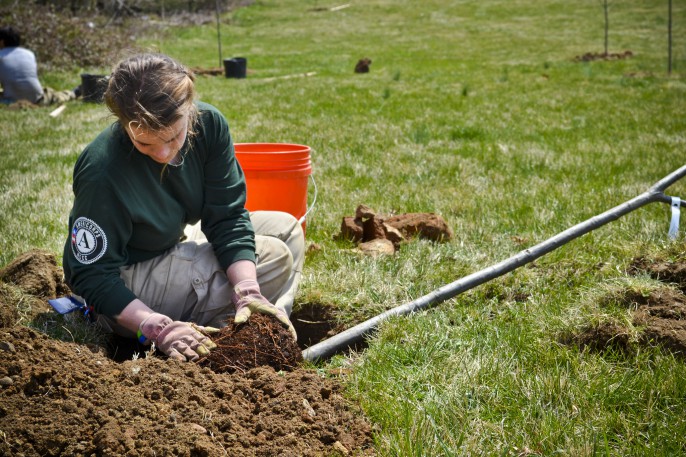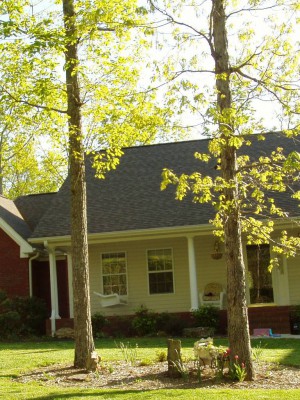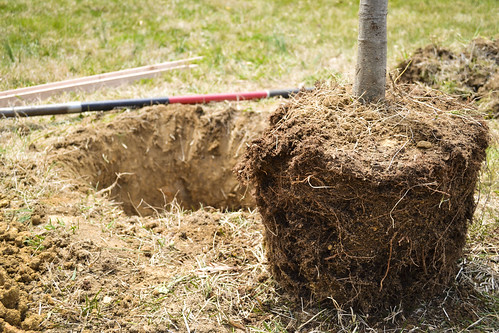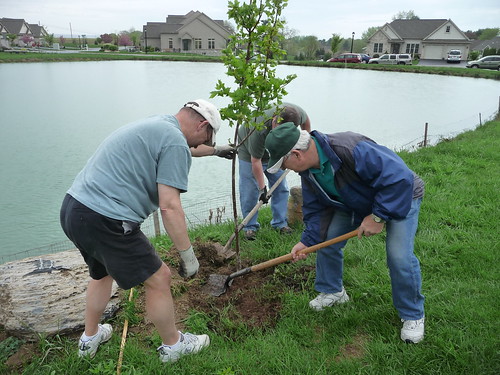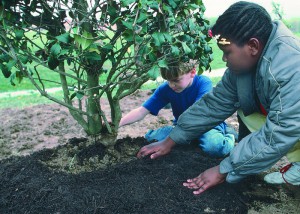Tree Planting
Planting trees in the landscape provide you benefits that can far exceed the costs of planting and maintaining them over their life span. These ecosystem services include cleaner air, higher property values, energy savings, increased wildlife habitat, stormwater runoff reduction and improved water quality.
One study showed that 100 mature trees catch about 139,000 gallons of rainwater per year. Trees can reduce the potential negative impacts of surface water runoff by intercepting and holding large volumes of precipitation on surface areas (ie. leaves, branches and trunks) while reducing soil erosion by slowing the speed of runoff on the ground. Trees extensive roots systems increase the infiltration and storage of stormwater in the soil.
Tree Maintenance

Some areas with high deer populations may require a deer guard to prevent deer from eating branches or rubbing off bark.
You’ll want to tend to your new trees and nurture them, especially within the first two years after planting. Maintenance is an extremely important aspect of tree survival and, when done properly, can ensure a healthy, long lived tree.
New plantings will need to be watered until the root system spreads. Provide water to the trees’ root system once a week after the initial planting and especially during the hot dry summer periods. Short frequent watering discourages roots from spreading out, so when watering it is important to provide plenty of water and allow it to fully soak into the ground.
Other maintenance considerations:
- Replace mulch as needed and eliminate the weed competition
- Consider deer, vole and other critter protection if needed
- Prune as needed to encourage proper form
Correctly Planting a Tree
An estimated 6.1 million homeowners in the Chesapeake Bay Watershed manage and maintain their own yards. Adding trees in the landscape will not only help protect local streams and rivers, but can result in direct and substantial cost savings and other benefits to the homeowners.
Plant the right tree in the right spot at the right time in the right way.
Right Tree
Trees come in a variety of shapes and sizes. Select trees that exhibit characteristics that help you achieve your objectives (wildlife, shade, wind break, privacy, aesthetics, stormwater reduction or a combination thereof).
Consider, also, the characteristics that you may find intolerable later. Sweetgum (Liquidambar styraciflua) is a fast growing hardwood tree that forms a nice crown. However, eventually it produces vast quantities of spiked, spherical autumn fruit that some homeowners find undesirable (especially to the unshod foot).
Understand the trees resources needs. All plants require sun, water and soil nutrients (and growing space too) in order survive. Trees tend to be able to thrive in varying amounts of each. Tulip poplar (Liriodendron tulipfera) is the tallest growing tree in the east but requires ample sunlight and soil moisture and nutrients to succeed. Flowering dogwood (Cornus florida) tolerates the shade, but exhibits its beautiful flowers, a characteristic many enjoy, more when receiving full light.
Give preference to native trees to your area. Native trees have adapted over time to the climate in your region. They tend to require less maintenance than many non native trees you may find at your local nursery. They also tend to provide better habitat for wildlife. At the same time, some nonnative trees can provide the same benefits as natives but can better tolerate a built environment.
Avoid invasive trees! Trees like Norway maple (Acer platanoides), Callery pear (Pyrus calleryana) and silk tree (Albizia julibrissin) were introduced to our region as ornamental plants. They are well adapted to our region and have escaped cultivation spreading into natural areas. They often outcompete native vegetation and tend to form monocultures.
Know thy enemies. Trees, like all pants, are subjected to stresses form herbivory, pathogens and anthropogenic (human caused) activities. Some of these stresses can be species specific. The emerald ash borer (Agrilus planipennis), for instance, attacks most species of our native ash, which are very common in the woods and urban area of this region. Infestation is usually fatal to the tree. The distribution of the emerald ash borer is growing in our region. Ash may not be a great investment for your yard at this time.
Right Spot
Your yard’s soil provides the water, nutrients and oxygen needed by your trees. The soil’s texture or particle size (percentage of sand, silt or clay) determines the availability of these resources. Sandy soils drain well but have less capacity to hold water and nutrients. Clay soils have a high nutrient holding capacity but tend to be poorly drained making nutrients and oxygen unavailable to vegetation. A soil test can help you determine what you land is providing so you can match it with the best trees adapted to those soil conditions.
The space you provide for your tree is also important. Determine how much sun exposure your trees will receive throughout the day at that location. Trees vary in their light requirements. American Beech (Fagus grandifolia) is much more tolerant of shade than a pin oak (Quercus palustris), which needs an open area.
Think about where water collects on your property after a rain. Trees vary in their tolerance of flooded soils. River birch (Betula nigra) or red maple (Acer rubrum) tolerate periodic wet sites while white oak (Quercus alba) or black cherry (Prunu serotina) do not.
Picture your trees as mature or fully grown. Is there anything in that spot that will inhibit their growth, pose a danger to you or your property, become an inconvenience to manage or require you to aggressively manage and prune?
Make sure you check community or local ordinances regulating tree planting and with you utilities for underground wires or other building infrastructure. Dig safely, call Miss Utility.
The Right Time
Trees can be planted anytime of the year if properly maintained. Howwever, the best time of the year to plant trees is in the early spring or in the fall. Spring plantings benefit from the rainy season after the soil has thawed. Fall plants are better for deciduous tree plantings as they are about to go dormant. Conifers like pine, cedars and spruce can be planted in the fall, but they may require periodic watering during mild winters.
The Right Way
Give your trees a good start. Planting a tree is more than digging a hole. There are many resources out there that will provide the necessary step to succeed. The process is pretty universal. These steps are an excerpt from treepeople.org.
- Dig in!
Dig a hole twice as wide as the root ball and slightly shallower than the root ball. (The root ball is comprised of all the roots contained in a pot. The top of the root ball begins where the roots start to emerge from the trunk.) - Roughen the soil
If your planting hole has slick sides, roughen the sides and bottom with a pick or shovel. This makes it easier for root tips to penetrate into the native soil. - Remove the container
Be gentle but firm when removing the container from your tree. Making sure to protect the foliage, lay the tree on its side with the container end near the planting hole. Hit the bottom and sides of the container until the root ball is loosened. Slide the pot off the root ball and gently lower the tree into the hole. - Separate the roots
Check the root ball for circling roots. If circling roots are left in place near the trunk, they will cut into the trunk as the trunk’s girth expands. Gently uncurl and straighten the roots so that they are going outward from the trunk. If a circling root is too stiff to move, you may need to cut it off, but be careful not to cut off too much of the root ball. If cutting circling roots will account for too much of the root ball, wait a year so that more roots will have grown. Do this quickly and shade the tree roots from the sun, so they don’t dry out and die. - Don’t bury the trunk
If soil covers the base of the trunk, it will lead to rot. Aim to have the top of the root ball about 1/2 to 1 inch above the surrounding soil surface, making sure not to cover it with soil unless roots are exposed. Adjust the hole depth by lifting the tree out of the hole (lift it by the root ball, not by the trunk) and adjusting the soil level in the planting hole. - Orient the tree
Orient the tree while you have the chance. Situate it so that branches won’t be in the way of pedestrian or car traffic. If you prefer a particular side of the tree, turn it toward a prominent viewpoint (such as your kitchen window). In sunny areas, orient the tree so that the best-shaded side of the trunk faces southwest. When turning the tree, lift it from the base of the root ball, not from the base of the trunk. - Make sure it’s upright
Once the tree is in the hole, stand back and make sure it’s standing upright. Tilt the root ball until the tree is straight, then backfill firmly under and around the root ball. - Give your soil a boost
If your native soil is hard to work with (e.g., heavy clay) or retains little moisture (e.g., very sandy), you can treat it to some organic amendment, such as compost. The amendment won’t be a permanent solution to soil deficiencies, but it will help retain water and air in the soil around the root ball for the first few vital years. If adding soil amendment, always mix it with soil from the planting site; about one part amendment to three parts native soil is a good proportion for backfill soil. - Pack the soil
Pack down the soil as you backfill. Using the heel of your foot or the handle end of the shovel, press down firmly to collapse any large air pockets in the soil. This will help stabilize the tree in the hole. Don’t wait until the planting is finished; press down every few shovels of soil. - Water!
Build a watering basin around the root ball by creating a berm a little larger than the root ball perimeter. This concentrates water to the root ball. A tree that has a dry root ball can stand in a moist backfill without absorbing water. You’ll need to water your tree thoroughly after planting with about 15 gallons of water. Monitor your tree’s water needs at least once a week for the first month. This will give you an idea as to the frequency your tree will need water growing in your particular soil. - Stake
Remove the nursery stake that came tightly tied to the trunk after planting. Stake the tree loosely for protection or support if needed. Use only soft, pliable tree ties. Do not use wire, even if it’s inside a hose. Wire can cut into a trunk. If the trunk can’t stand up on its own, stake it so that it stands upright. The stakes should be placed outside of the root ball. Plan to remove stakes as soon as the tree can support itself, in 6 to 12 months. - Mulch
Cover the entire planting area with a 3 to 4-inch layer of mulch, but keep it 2 inches from the base of the trunk. Mulch keeps the topsoil temperate for root growth, reduces surface evaporation of water, slows or stops weed and grass growth around the tree’s base, and prevents a hard crust from forming on the soil surface. Do not create a mulch mountain!
